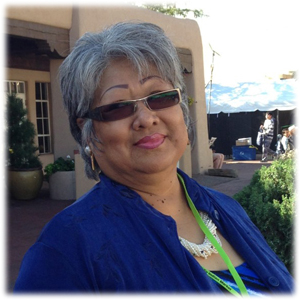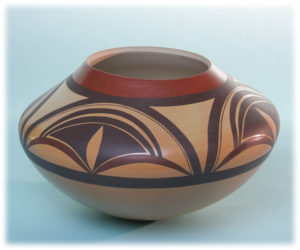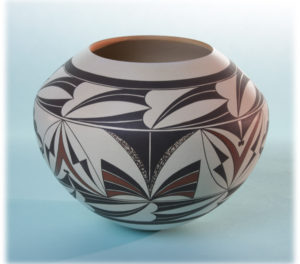Yvonne Lucas

Born Yvonne Nalla on June 30, 1959 at Blue Water, New Mexico , Yvonne is the third of five children with one sister and three brothers. She grew up in Gallup New Mexico where she currently lives with her husband, Steve Lucas and their 11 year old daughter Natashia.
Yvonne is a graduate of the University of New Mexico, Gallup, and attended beauty school in Albuquerque, and has studied at floral school. She managed a floral shop in Gallup and was a practicing beautician in Gallup for four years.
She had her first child at the age of 17, while she was still in High School. Christopher is now 22 years old. Her parents were very strict and her father required her to marry when she became pregnant. That marriage lasted two years. Yvonne and Steve have been married for five of the last fourteen years they have been together.
At the time of this interview, November 1998, Yvonne had been potting for two years five months. In that time period, she had completed only 25 to 30 pots measuring in size from as small as 3 inches up to 13 inches in diameter. What she enjoys most about potting is the opportunity to use her god given talent. She says that it keeps one humble, requires a clear mind and gives her a clear sense of where she is from.
At the urging of Dextra Quotskuyva, Yvonne began to help Steve with his potting when he began to earn enough to support the family. Beginng with straining the clay through the legs of old blue jeans to sanding and firing she learned the process directly from Steve. In addition, her experiences with other Nampeyo family members has influenced her techniques of molding, painting, and firing.
Yvonne says, “I can’t believe I’m able to sell pots for what I do.” She is unable to mine clay from her ancestral village of Laguna, and would not feel right using Hopi clay and Nampeyo designs. Accordingly, her unique pots are often a hybrid of Hopi clay finished with a Laguna like white slip. They are painted with historically influenced Laguna designs.
Not surprisingly, Yvonne won second prize in one of the first competitions she entered at the Eiteljorge Museum show in Indianapolis, Indiana. The judge, Doug Hyde, commended her for the evenness, balance, fine lines, and other technical aspects of her pottery.
In determining the price for a pot many factors are considered. Although clay is mined on the reservation without cost, there are considerations of processing time and costs associated with “quita” fuel, strainers, old blue jean legs, and multiple brushes. Different brushes are required for red slip, white slip and fine line brushes that are clipped to as few as six hairs. Sacrifices of time from family, time away from the fields, and time for cultural ceremonies are all taken into account.
Many buyers believe that a smaller pot will always cost less. Yvonne says that smaller pots are really no easier to make, to paint or to fire. They often take as much or more time to complete, and are generally fired one at a time.
Showing all 3 results, including child brands



